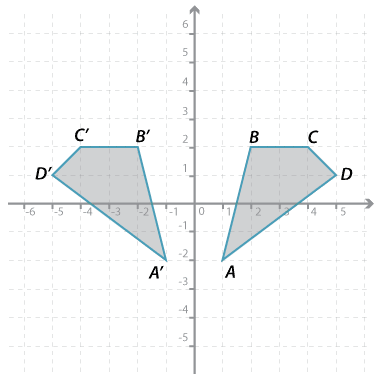![]()
Question 3
The quadrilateral \(ABCD\) is reflected in the \(y\)-axis to form rectangle \(A^\prime B^\prime C^\prime D^\prime\).
Give the \(x\)-coordinate and the \(y\)-coordinate of each of the following:
| \(x\) = | \(y\) = | Submit answer | |
|---|---|---|---|
| a \(A^\prime\) | ( , | ). | |
| b \(B^\prime\) | ( , | ). | |
| c \(C^\prime\) | ( , | ). | |
| d \(D^\prime\) | ( , | ). |
Place answers in both checkboxes before submitting.
Question 4
The rectangle \(ABCD\) is reflected in the \(y\)-axis to form rectangle \(A^\prime B^\prime C^\prime D^\prime\). The coordinates of each of the vertices of \(ABCD\) are as follows:
\(A(1, 6), B(1, 9), C(2, 9), D(2, 6)\).
Give the \(x\)-coordinate and the \(y\)-coordinate of:
| \(x\) = | \(y\) = | Submit answer | |
|---|---|---|---|
| a \(A^\prime\) | ( , | ). | |
| b \(B^\prime\) | ( , | ). | |
| c \(C^\prime\) | ( , | ). | |
| d \(D^\prime\) | ( , | ). |
Place answers in both checkboxes before submitting.





